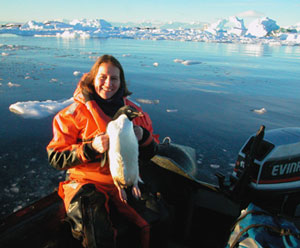|
|
 |
Images
and Facts - Facts
Gallery | Dispatch
Images | Facts | References
Comparison of the Arctic and
Antarctic
by C. A. Linder
Even though they are both at the "ends of the earth," the
Arctic and Antarctic differ in many ways. The Arctic is a vast ice
covered ocean surrounded by land. The pack ice ranges in thickness
from a few inches to over 6 feet, below which are deep basins of seawater
just above the freezing point. The icy surface of the Arctic Ocean
is thin enough to be traversed by icebreakers, especially in summer
when the extent of the ice is at a minimum. There is no fixed marker
for the North Pole, since the ice sheets are constantly shifting.
The exact location of the Pole is determined using satellite navigation,
or GPS (Global Positioning System).
 |
 |
| WHOI scientist
Carin Ashjian holds an Adelie penguin in the Southern Ocean.
Penguins are only found in the Antarctic. |
In contrast, the Antarctic is a giant landmass surrounded by ocean.
This has a radical effect on Antarctica's climate. On a summer’s
day, Antarctic surface temperatures are considerably colder (-30°C,
dropping to -60°C on an average winter’s day)
than those in the Arctic, because land masses lose and gain
heat faster than water. Glaciers up to 3,000 meters thick and covering
98-99% of the land rest on the Antarctic continent. Unlike the North,
the South Pole is a permanent site marked by a brass pole with an
engraved plaque (there is only imperceptible shifting of the landmass
or its ice covering).
The vast belt of warm water between the Arctic and Antarctic has caused
the creatures in each region to evolve independently. For example,
polar bears are only found in the Arctic and penguins only in the
Antarctic. There are many land mammal species in the north, as animals
have been able to migrate across the landmasses surrounding the Arctic.
Comparatively warmer summers allow a greater range of animals to survive.
Some of the 40 species of Arctic land mammals are migratory, going
south in the much colder winters. Antarctica, on the other hand, is
separated from its neighboring landmasses by the Southern Ocean. The
largest land animal is the midge, a mere 1mm long.
The Southern Ocean is extremely productive, and is an important habitat
for seabirds and marine mammals.
For a pictorial comparison of the poles, I recommend renowned photographer
Galen Rowell's book Poles Apart: Parallel Visions of the Arctic
and Antarctic. In Rowell's words, the Arctic and Antarctic are
as “unalike as Kansas and Kenya.”
Back to Facts Index
|
|




